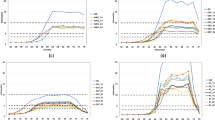Summary
The total score of a quality of life (QOL) questionnaire reflects the items that make up the questionnaire. Although different questionnaires have strikingly similar items, the balance between types of items can affect research outcomes. Four general quality of life (QOL) scales and one specific scale may be compared to show how the balance of items can bias the results to: (a) increase or decrease the chance of obtaining a significant result in a clinical trial; (b) make one treatment appear better or worse compared with that of a competitor; (c) make the QOL of one disease category appear better or worse than that of another disease category. Healthcare decision-making should be based on relatively unaggregated measures of health.
Similar content being viewed by others
References
Anastasi A. Psychological testing, 6th ed., Macmillan, New York, 1988
Bowling A. Measuring health: a review of quality of life measurement scales. Open University Press, Milton Keynes, UK, 1991
Hunt SM, McEwen J, McKenna S. Measuring health status. Croom Helm, London, 1986
Bergner M, Bobbitt RA, Carter WB, Gilson BS. The Sickness Impact Profile: development and final revision of a health status measure. Medical Care 19: 787–805, 1981
Freund DA, Dittus RS. Principles of pharmacoeconomic analysis of drug therapy. PharmacoEconomics 1: 20–29, 1992
Goldberg D, Williams P. A user’s guide to the General Health Questionnaire. NFER-Nelson, Windsor, UK, 1988
Hyland ME, Finnis S, Irvine SH. A scale for assessing quality of life in adult asthma sufferers. Journal of Psychosomatic Research 35: 99–110, 1991
Jaeschke R, Guyatt GH, Cook D. Quality of life instruments in the evaluation of new drugs. PharmacoEconomics 1: 84–94, 1992
Kaplan RM, Bush JW. Health-related quality of life measurement for evaluation research and policy analysis. Health Psychology 1: 61–80, 1982
Kaplan RM, Anderson JP. The general health policy model: an integrative approach. In Spilker B (Ed.) Quality of life assessment in clinical trials, pp. 131–149, ((publisher to come)), 1990
Spilker B. Standardisation of quality of life trials: an industry perspective. PharmacoEconomics 1: 73–75, 1992
Stewart AL, Hays RD, Ware JE. The MOS short-short form general health survey. Medical Care 26: 724–735, 1988
Author information
Authors and Affiliations
Additional information
An erratum to this article is available at http://dx.doi.org/10.1007/BF03260127.
Rights and permissions
About this article
Cite this article
Hyland, M.E. Selection of Items and Avoidance of Bias in Quality of Life Scales. Pharmacoeconomics 1, 182–190 (1992). https://doi.org/10.2165/00019053-199201030-00005
Published:
Issue Date:
DOI: https://doi.org/10.2165/00019053-199201030-00005




